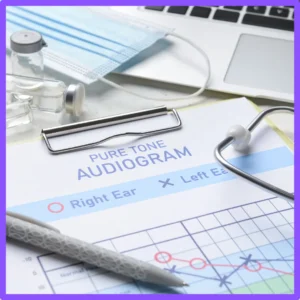Unlock the World of Sound: All About Hearing Tests
Your ability to hear shapes how you connect with the world around you. Whether it’s enjoying a heartfelt conversation or hearing the rustle of leaves, sound enriches your life. Hearing tests are the first step in ensuring you don’t miss out. Let’s explore hearing tests, why they matter, and how they help diagnose and treat hearing issues.
What Are Hearing Tests?
Hearing tests are evaluations designed to measure how well you perceive sounds at different volumes and pitches. These assessments help uncover hearing loss, its severity, and its cause, offering a clear path to treatment.
Your hearing relies on an intricate process that transforms sound waves into electrical signals your brain understands. Here’s how it works:
- Sound Waves Enter the Ear: Sounds travel through your outer ear to the eardrum.
- Vibrations Amplify the Sound: The eardrum vibrates, and three tiny bones in the middle ear amplify the vibrations.
- Signals Reach the Inner Ear: These vibrations move fluid inside the cochlea, a spiral-shaped structure in the inner ear.
- Hair Cells Create Electrical Signals: Sensory hair cells in the cochlea convert fluid movement into electrical signals.
- Brain Interprets Sounds: The auditory nerve sends signals to the brain, which processes them as recognizable sounds.
Hearing loss happens when something disrupts this process. Hearing tests pinpoint where and why the breakdown occurs, empowering hearing care providers to offer personalized solutions.
Types of Hearing Tests for Adults
Hearing care providers use a variety of tests to diagnose hearing loss and its underlying causes. Each test examines a specific part of your auditory system, ensuring no detail is overlooked.

1. Pure-Tone Testing
Pure-tone testing is the cornerstone of hearing evaluations.
What it does: Measures your ability to hear tones at varying pitches and volumes.
How it works:
- You wear headphones in a soundproof booth.
- Tones at different frequencies and intensities play through the headphones.
- You indicate when you hear a sound, helping create an audiogram—a visual chart of your hearing ability.
This test reveals the softest sounds you can detect and helps diagnose hearing loss.
2. Speech Testing
Speech testing evaluates your ability to understand words in different listening environments.
What it does: Assesses speech clarity and comprehension.
How it works:
- Words are played at various volumes, sometimes with background noise.
- You repeat the words to show how well you can distinguish speech from noise.
This test helps mimic real-world challenges, like conversations in busy restaurants, offering insights into potential improvements with hearing aids.
Find out more about understanding speech.
3. Bone Conduction Testing
Bone conduction testing bypasses the outer and middle ear to assess inner ear function.
What it does: Determines whether hearing loss is conductive (blockage) or sensorineural (inner ear damage).
How it works:
- A small device behind your ear vibrates, sending signals directly to the cochlea.
- Results are compared with pure-tone testing to identify the type of hearing loss.
4. Tympanometry
Tympanometry focuses on the movement of your eardrum and middle ear.
What it does: Detects issues like wax buildup, fluid, or perforations in the eardrum.
How it works:
- A probe gently changes the air pressure in your ear.
- The test records how well your eardrum vibrates, creating a graph of its movement.
This test is crucial for diagnosing middle ear problems.
5. Otoacoustic Emissions (OAE)
OAE testing evaluates the health of sensory hair cells in your inner ear.
What it does: Identifies inner ear damage and confirms hearing loss.
How it works:
- A tiny probe plays sounds into your ear and records your cochlea’s response.
- A lack of response indicates a possible sensorineural hearing loss.
6. Auditory Brainstem Response (ABR)
ABR testing measures how your brain processes sound.
What it does: Diagnoses sensorineural hearing loss and auditory nerve issues.
How it works:
- Electrodes placed on your scalp record brain activity as you hear sounds.
This test is often used for infants or individuals unable to respond to traditional hearing evaluations.
7. Acoustic Reflex Testing
Acoustic reflex testing examines involuntary muscle contractions in your middle ear.
What it does: Pinpoints the location and severity of hearing loss.
How it works:
- A probe emits sounds to trigger muscle responses.
- The test records whether these reflexes usually occur.
8. Tuning Fork Tests
Simple and effective tuning fork tests differentiate between conductive and sensorineural hearing loss.
What they do: Compare how sound travels through air versus bone.
How they work:
- A vibrating tuning fork is placed on your head or near your ear.
- You report whether the sound is louder through air or bone.
These tests are quick and often used during initial screenings.

Understanding Hearing Test Results
Results are displayed on an audiogram, a chart showing the softest sounds you can hear at various pitches. Your hearing care provider will explain the results and recommend next steps if hearing loss is detected.
Degrees of Hearing Loss:
- Mild: 26–40 decibels (e.g., difficulty hearing soft speech).
- Moderate: 41–70 decibels (e.g., trouble following conversations without hearing aids).
- Severe: 71–90 decibels (e.g., reliance on amplified devices or lip-reading).
- Profound: 91+ decibels (e.g., limited sound recognition without assistive devices).
Learn more about audiograms here.
Benefits of Routine Hearing Tests
Regular hearing tests offer numerous advantages:
- Early detection: Address hearing loss before it worsens.
- Improved communication: Reduce misunderstandings in conversations.
- Better mental health: Stay socially active and prevent isolation.
- Enhanced safety: Recognize alarms, alerts, and other crucial sounds.
When Should You Get a Hearing Test?
Adults should get a baseline hearing test if symptoms arise by age 50 or earlier. Regular testing every 3–5 years ensures consistent monitoring. If you work in noisy environments, consider annual evaluations.

Why Hearing Tests Matter
Hearing tests do more than diagnose hearing loss—they open doors to solutions that improve your quality of life. They help identify challenges early, enhance communication, and protect your mental well-being.
Don’t let hearing issues go unchecked. Contact Stanford Hearing’s expert team to guide you toward better hearing health. Schedule your hearing test today and rediscover the sounds that make life extraordinary.
